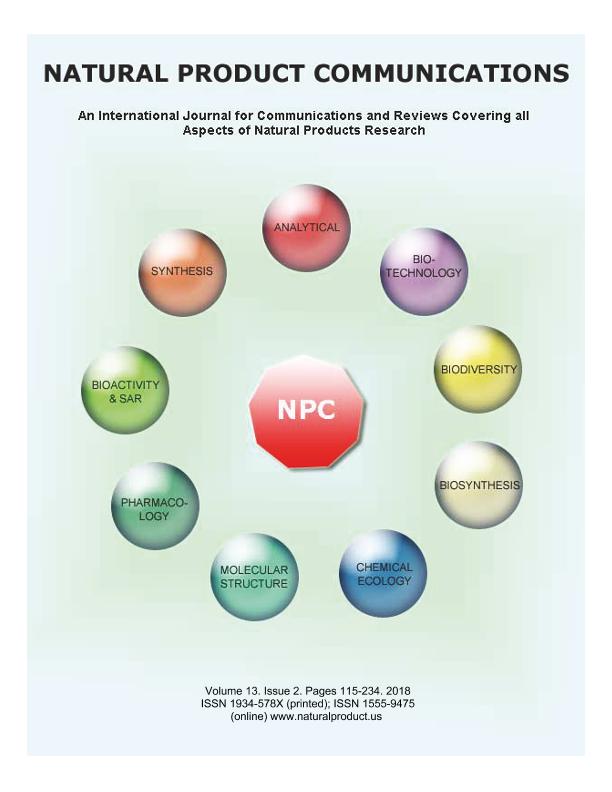Artículo
Argentinean Larrea Dry Extracts with Potential Use in Vaginal Candidiasis
Moreno, María Alejandra ; Córdoba, Susana Beatríz; Zampini, Iris Catiana
; Córdoba, Susana Beatríz; Zampini, Iris Catiana ; Mercado, Maria Ines
; Mercado, Maria Ines ; Ponessa, Graciela Ines; Sayago, Jorge Esteban; Pino Ramos, Liudis Leydi; Schmeda Hirschmann, Guillermo; Isla, Maria Ines
; Ponessa, Graciela Ines; Sayago, Jorge Esteban; Pino Ramos, Liudis Leydi; Schmeda Hirschmann, Guillermo; Isla, Maria Ines
 ; Córdoba, Susana Beatríz; Zampini, Iris Catiana
; Córdoba, Susana Beatríz; Zampini, Iris Catiana ; Mercado, Maria Ines
; Mercado, Maria Ines ; Ponessa, Graciela Ines; Sayago, Jorge Esteban; Pino Ramos, Liudis Leydi; Schmeda Hirschmann, Guillermo; Isla, Maria Ines
; Ponessa, Graciela Ines; Sayago, Jorge Esteban; Pino Ramos, Liudis Leydi; Schmeda Hirschmann, Guillermo; Isla, Maria Ines
Fecha de publicación:
02/2018
Editorial:
Natural Products
Revista:
Natural Product Communications
ISSN:
1934-578X
e-ISSN:
1555-9475
Idioma:
Inglés
Tipo de recurso:
Artículo publicado
Clasificación temática:
Resumen
Larrea divaricata (Ld), Larrea cuneifolia (Lc) and Larrea nitida (Ln) are shrubs occurring in Northwestern Argentina used in traditional medicine to treatfungal and bacterial infections and as anti-inflammatory. Antibacterial and antifungal activity of several Larrea species has been reported. However, theirpotential use in vaginal infections has been so far not assessed. The aim of this work was to determine the botanical difference between Larrea species, thechemical composition and the activity of Larrea dry extracts (DE) on Candida species isolated from vaginal infections and to assess their potential asantioxidant agents because infections are usually associated with oxidative processes. The main botanical difference between Larrea species resides in themorphology and shape of leaf, leaflets and stipules, presence or absence of mucron and rachis, percentage of coalescence of the leaflets. The position andabundance of the sclerenchymatic tissue at the mind vein and petiole transection allows the differentiation of the three species. The profile of phenoliccompounds in the Larrea DE was determined. HPLC-ESI-MS/MS analysis of DE allowed the identification of 2 flavonoids and 10 lignans. Trihydroxy-6,7´cyclolignan was found only in L. divaricata and dihydroxy-methoxy-epoxylignan in L. cuneifolia and L. nitida, nordihydroguaiaretic acid (NDGA) wasfound in the three species. All extracts showed antioxidant capacity. The DE showed to be effective against Candida albicans and non-albicans strains.According to our results, the local vaginal use of Larrea DE in the concentration range of MIC values for Candida species does not affect the Lactobacillusnormal vaginal microbiota. This work adds evidence to the potential use of Larrea DE as phytomedicine in vulvovaginal candidiasis with multiple effects,including antifungal and antioxidant activity.
Palabras clave:
Larrea species
,
Dry extracts
,
Antioxidant
,
Anti-Candida
Archivos asociados
Licencia
Identificadores
Colecciones
Articulos(INQUINOA)
Articulos de INST.DE QUIMICA DEL NOROESTE
Articulos de INST.DE QUIMICA DEL NOROESTE
Citación
Moreno, María Alejandra; Córdoba, Susana Beatríz; Zampini, Iris Catiana; Mercado, Maria Ines; Ponessa, Graciela Ines; et al.; Argentinean Larrea Dry Extracts with Potential Use in Vaginal Candidiasis; Natural Products; Natural Product Communications; 13; 2; 2-2018; 171-174
Compartir
Altmétricas



